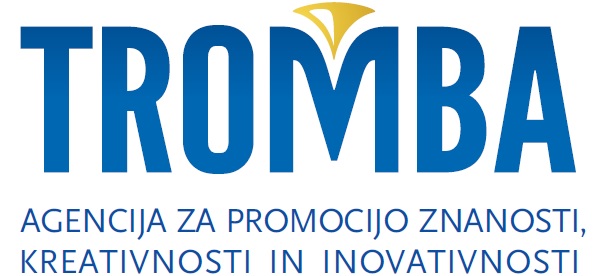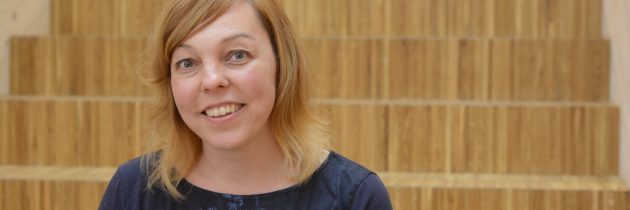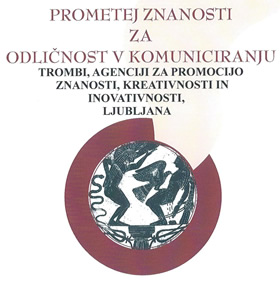Dr. Anna Sandak, prejemnica ERC; projekt ARCHI-SKIN
Dr. Anna Sandak, uspešna raziskovalka poljskega rodu z doktoratom iz znanosti o lesu in magisterijem iz biologije, je bila izbrana v tesni konkurenci kandidatov za financiranje projektov s strani ERC. Uspešno predstavljen projekt ARCHI-SKIN, skoraj dva milijona evrov vreden petletni projekt, bo vodila na gostiteljski ustanovi INNORENEW.
Projekt je dr. Sandak prijavila na novi ERC panel za inženiring materialov, v okviru katerega so izbrali le 12 projektov, kar kaže na izjemno uspešnost. Hkrati je to v Sloveniji prvi ERC projekt za utrjevanje samostojne raziskovalne kariere.
Kot pojasnjuje, bo razvila biofilm, ki ščiti površine iz biomaterialov, betona, plastike in kovin, hkrati pa ima funkcijo naravnega samopopravljanja. Ta novost bo pospešila prehod od tradicionalnih konceptov o materialih k razvoju inženirsko spremenjenih živih materialov, ki so sposobni medsebojne interakcije in prilagajanja okoljskim spremembam. Ker gre za nov koncept zaščite materiala, ga bodo morali zaradi prisotnosti živih celic uporabniki šele sprejeti. Novost bo v prihodnosti gotovo okrepila sodelovanje z industrijo. Zahtevnost projekta bo presegala zgolj laboratorijsko raziskovanje. Uporabili bodo najnovejša orodja za slikanje živih celic, pa tudi podatkovno znanost in strojno učenje.
—————————————————————————————————————
Dr. Anna Sandak, you are a researcher at the Innorenew CoE Centre of Excellence for Research and Innovation in Renewable Materials and Healthy Living. It is an institution with an outstanding research programme, which is at the heart of a healthy environment. What attracted you to this field of work?
The research at InnoRenew CoE targets renewable materials and sustainable buildings, with emphasis on innovative approaches to the use of wood. Our core focus is on the creation of better built environments for people and the environment, using renewable materials. In 2017, I was invited to prepare a research and development plan and lead the wood modification group, which gives me a lot of freedom and independence in future research. We are approaching wood modification and functionalisation in new and alternative ways while taking into consideration the intrinsic properties of the material, fit-for-purpose performance and environmental aspects. I believe that our uniqueness is the implementation of biomimetic principles in the development of new materials and modification processes. This research path brought me to the ERC ARCHI-SKIN project where we will advance the development of engineered living materials that can interact, adapt and respond to environmental changes.
You have a PhD in wood science and a Master of Science in biology. How do you combine the two fields in your research work? Have you found an interdisciplinary approach to research?
Indeed, I’m a biologist and a materials scientist. The ARCHI-SKIN project allows me to integrate my experience related to multiscale characterisation and performance of biobased building materials with novel concepts of developing a living coating system. I believe that interdisciplinarity is key to new discoveries today. I’m leading a wood modification group; a team of nine researchers from six different countries, including chemists, physicists, material scientists, engineers, biologists, and psychologists. I would like to consolidate my research with the ARCHI-SKIN project to achieve scientific excellence and push conventional materials engineering in a new direction.
You have been awarded a prestigious ERC project to consolidate your independent research career, and you will lead a 5-year project worth around €2 million euros at an INNORENEW host institution. What specifically will you be researching?
The overall objective of the ARCHI-SKIN project is to comprehensively evaluate the chemistry, structure and interaction of fungal biofilms, and to use what we learn to develop a living architectural coating system. We will explore the design principles underlying fungal biofilms to advance the knowledge of how they work and what their properties are. To achieve this, we will develop new laboratory routines and use the latest tools in live cell imaging, data science and machine learning. My idea is to develop a bioactive protective coating system that works in harmony with nature and benefits from the synergetic efforts of living fungal cells, bio-based ingredients and bioinspired concepts for materials design.
How does one prepare an application for the ERC, must you formulate your research in order to compete?
If you are referring to the preparation of a wining project application, I think there is no universal recipe to guarantee success. Nevertheless, some elements should be present in a good project proposal. The project should target needs that are stated in the specific call, which seems obvious. However, as scientists we are often tempted to propose something that is extremely interesting for us, but not necessarily for rest of the word. ERC calls are very flexible in this regard, there are 27 peer review panels covering most fields of science. Any topic can be submitted, but proposals should be “high-risk/high-gain” with objectives that are ambitious and beyond the state of the art. This gives a lot of freedom, but the proposed science must be possible to implement given what you describe in the work plan. Finally, the principal investigator should convince reviewers that he/she is capable of conducting ground-breaking research and successfully executing the project. I believe that this is possible to achieve by working with a good, inspiring team and with support from the host institution.
You are doing basic research. Are you considering the possible applications of your research results, even though this is not an explicit requirement of the ERC?
Within ARCHI-SKIN we will develop a biofilm that protects biomaterial, concrete, plastic and metal surfaces. The coating formulation will be optimised for various climates and possess novel properties such as self-repair and bioremediation. I believe that this will be highly attractive to the industrial sector, but I’m also aware of potential upscaling issues. Moreover, we are proposing a new concept of material protection, that, due to the presence of living cells, will need to be accepted by end-users. All those aspects will be researched during the project, and I hope to reinforce collaboration with industry in coming years.
ERC grants are prestigious and lend a great deal of recognition to scientific work. What advice would you give to your fellow researchers who want to apply for an ERC call? The competition is incredible every year, what advice could you give them?
Indeed, the competition is intense. The success rate this year was less than 12% but the grants give a lot of opportunities, so it is definitely worth trying. You should think out of the box and convince reviewers that you are the one who should conduct this research. You should demonstrate your passion, especially during the interview process in which you must be confident but not arrogant. There are different funding schemes depending on the stage of your career, so a second chance is possible. However there are certain threshold restrictions for re-applicants, so prepare your proposal very well and try! – who never plays, will never win.
Foto. innorenew






